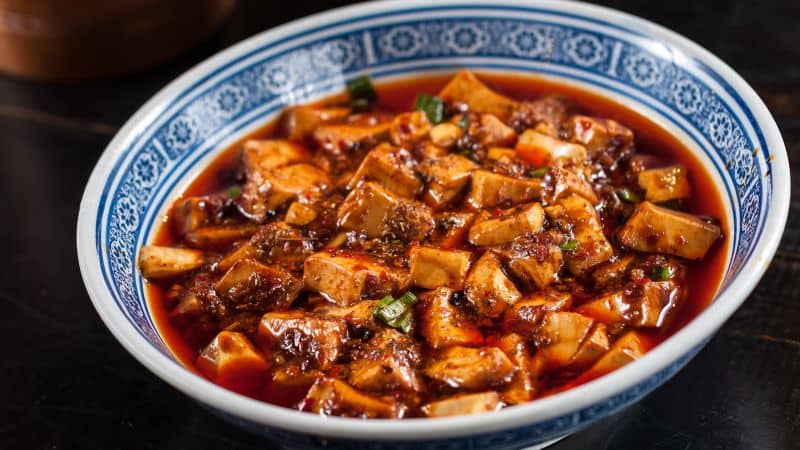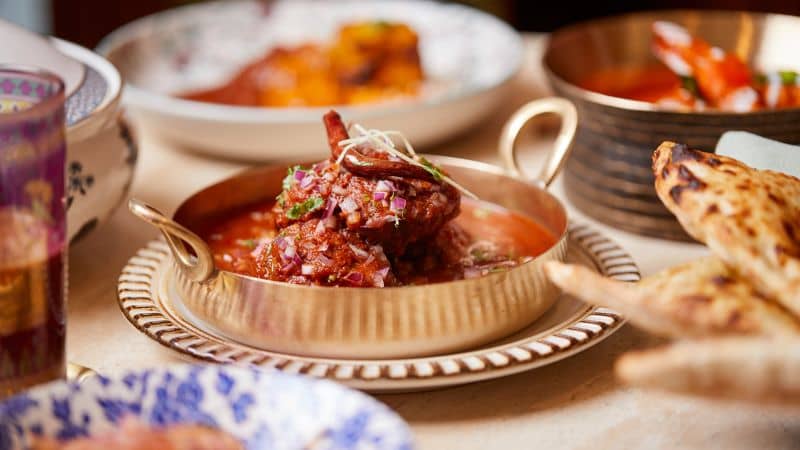CNN — With one of the world’s most diverse food scenes, China makes it nearly impossible to put together one single list that truly encompasses the “best” Chinese dishes. But with such

CNN
—
The escalating climate crisis is shifting many people’s purchasing patterns and this extends to the $500 billion dollar global beauty industry which is grappling with a range of sustainability challenges across product manufacturing, packaging and disposal.
Strategy and consulting firm Simon Kucher’s Global Sustainability Study 2021 found 60% of consumers around the world rated sustainability as an important purchase criterion, and 35% were willing to pay more for sustainable products or services.
This shift in consumer preferences has propelled many beauty brands to set environmental goals: to move away from single-use and virgin plastics, provide recyclable, reusable and refillable packaging and offer more transparency around products’ ingredients so customers can ascertain how “green” their purchase is.
However, consumers still struggle to understand the sustainability credentials of many products, according to the British Beauty Council. This is because the industry’s clean-up efforts have been inconsistent, and fall short of making a recognizable impact in the absence of collective goal-setting, global strategy and standardized regulations.
Ingredient and branding transparency
There is no international standard for the beauty industry on how much product ingredient information to share with customers — or how to do so. Brands can set their own rules and goals, giving rise to confusion and “greenwashing,” where sustainability claims are often touted but not substantiated.
Companies often use marketing language like “clean beauty” to make it seem like their products are natural, for example, when they may not actually be organic, sustainable or ethically made.
“The term ‘clean beauty’ has become quite dangerous. It’s used to sell more products,” according to British Beauty Council CEO Millie Kendall, who added that such buzzwords are losing traction in the UK as British customers wise up to their shortcomings. “Customers need better marketing information and certification information.”
In a 2021 report calling on the industry to have “the courage to change” their business practices, the British Beauty Council wrote that, all too often, even natural ingredients involved in manufacturing products give way to “over-consumption, non-regenerative farming practices, pollution, waste and neglect.”
“The only way out of this is transparency,” Kendall told CNN.
Jen Lee, chief impact officer at US-based brand Beautycounter, said she continues to see confusion over ingredients among consumers. (In 2013, the company launched and published “The Never List,” which currently cites more than 2,800 chemicals — including heavy metals, parabens and formaldehyde — it claims to never use in its products.)
“Natural vs. synthetic ingredients has been a conversation. People think natural is safer, but it’s not always the case,” Lee explained. “Natural ingredients formulated in the industry can have toxic load. Heavy metals can occur in natural components of the earth.”
“We used to be more natural and organic,” added Sasha Plavsic, founder of makeup brand ILIA Beauty. “What was challenging is (that) raw materials were difficult to source or would come in inconsistently or products wouldn’t perform.”
Most makeup is created and molded at high temperatures, Plavsic explained. Purely organic materials often fall apart in this heat, leading to inconsistent results and subpar product performance. “Not every synthetic is bad,” Plavsic said. “Sometimes, it helps create the best in class formula.”
The industry’s plastic packaging is a particular sustainability challenge — 95% is thrown away and the vast majority is not recycled, according to the British Beauty Council.
The cosmetics business is the fourth biggest plastic packaging user globally — after food and beverage, industrial packaging and pharmaceuticals — and plastic is about 67% of the industry’s packaging volume, according to Vantage Market Research. Beauty giant L’Oreal used 144,430 metric tons of plastic in its packaging material in 2021, for example, according to the Ellen Macarthur Foundation (EMF). Estee Lauder Companies reported its brands produced 71,600 metric tons of plastic in product packaging that same year.
And only 9% of the global plastic waste is recycled, according to a report from the Organisation for Economic Co-operation and Development. The United States only recycles 4% of its plastic waste.
Many brands are trying to phase out harmful plastics from their operations and adopt post-consumer recycled (PCR) plastic. (L’Oreal has set a target of 50% PCR plastic usage by 2025, while Estee Lauder is targeting 25% “or more” PCR plastic — but both are far from achieving their targets.)
“Between 60-70 major global brands have made unprecedented progress” in PCR plastic usage across industries, EMF’s Plastic Initiative Lead Sander DeFruyt told CNN. But DeFruyt stressed that PCR plastic must be adopted in conjunction with brands removing single and virgin plastics from their usage cycles to truly make a difference.
However, PCR plastic is not easy to find — low recycling rates around the world mean there is limited supply. Meanwhile, demand for it is growing demand across industries, DeFruyt said. This competition hikes up its price, which is already higher than virgin plastic.
Hair care brand FEKKAI claims that it used up to 95% PCR content in its packaging, but pricing and supply issues posed a challenge, forcing it to currently aim for containers and packaging that feature at least 50% PCR in its packaging.
“PCR plastic is more expensive than stock plastic. The cost is hard and then sourcing it is too,” founder Frédéric Fekkai told CNN. “PCR is close to our heart, but there is a massive demand, so finding recycled plastic is difficult.”
Beauty retailers plays a pivotal — and under-utilized — role, with control over stocking decisions and supply chains. But many vary when it comes to the standards they set for brands they sell.
“Smaller businesses do more, full stop,” said Jessi Baker, founder of the technology platform Provenance, which helps brands display their sustainability credentials for customers. “They move more nimbly. Some of them are born-good brands — climate friendliness was part of their setup. They don’t need to restructure their entire supply chain. Their culture already has it compared to the larger brands who need to work hard to change.”
Sephora launched its “Clean + Planet Positive” initiative in 2021, which labeled products that met its set criteria. (This is separate from the French retailer’s “Clean at Sephora” program, which is currently facing a consumer lawsuit alleging it carries a significant percentage of products understood by customers to be harmful.) Target launched a similar program in 2022, featuring a “Target Zero” icon for both online and in-store offerings that either have reusable, recyclable, compostable or reduced plastic packaging, or feature waterless or concentrated products.
Still, many steps taken by brands and retailers do not even begin to touch on the waste and pollution generated throughout supply chains, manufacturing and shipping, all huge problems for the industry to grapple with.
The gaps in standardization in the beauty ecosystem can, to some extent, be filled by certifications such as the US-born B Corporation, or B Corp. This accreditation, one of the most well-known in the beauty space, is issued by the non-profit B Lab, which scores a company on a variety of criteria around ethics and sustainability. However beneficial it may be among eco-conscious consumers, though, it is currently completely voluntary for brands to apply for.
Governments and multinationals enforcing regulations and setting a base line for brands to operate from when making sustainability claims would go a long way to making change, many experts and business leaders believe.
Susanne Kaufmann, founder of her namesake beauty brand, says her efforts in Austria would reap better results if more countries around the world had stricter, more uniform garbage disposal laws.
“I package our product in a recyclable material,” Kaufmann said. (Her products’ packaging, which is refillable and reusable, is made from 75% recycled plastic — and is 100% recyclable.) If I send this to the US, the garbage is not separated… and it’s not recyclable,” she explained, referring to inconsistencies in recycling laws across the United States.
And when it comes to ingredients, the European Chemicals Agency lists 2,495 substances banned from use in cosmetic products marketed for sale or use in the bloc. But the US Food and Drug administration only lists 11, making it more challenging for American consumers to find safer, greener options. The Environmental Working Group, a non-profit watchdog, studied lab tests of 51 sunscreen products in 2021 and found that only 35% of products met the EU standard, compared with 94% that passed the US standard.
However, while government can set minimum requirements, Mia Davis, vice president of sustainability and impact at beauty retailer Credo Beauty, says the needle will move in the private sector.
“Regulation can raise the floor a bit. A person who doesn’t know about any (sustainability issues) should still be able to walk into a bodega and get clean products… But that’s never going to be what the market can do,” she said. “Market leadership is key.”
In the absence of bold regulations or global standards on sustainability practices, this “leadership” — undertaken both by brands and customers in the beauty marketplace — is likely to be the most immediately impactful vector for addressing the industry’s climate shortcomings. It will take continued collective advocacy and initiative to see meaningful climate-conscious change.
Don't Miss
CNN — Paul Templer was living his best life. He was 28 and conducting tours in his native Zimbabwe, with
CNN — Coco Gauff was ruthless and totally dominant in her US Open quarterfinal against Jelena Ostapenko, dropping just two
CNN — Before a ball was even hit at this year’s US Open, many would have predicted three of the
20 best German foods | CNN
CNN
—
German food is rich, hearty and diverse. It’s comfort eating with high-quality, often locally sourced ingredients.
The cuisine of Germany has been shaped not only by the country’s agricultural traditions but by the many immigrants that have made the country home over the centuries.
It’s definitely more than a mere mix of beer, sauerkraut and sausage.
Today Germans appreciate well-prepared, well-served meals as much as they do a quick bite on the go. This is a country of food markets, beer gardens, wine festivals, food museums and high-end restaurants.
So: Haben sie hunger? Are you hungry now? Check out our list of 20 traditional German dishes that you need to try when you travel there.
Named after the former East Prussian capital of Königsberg (now Kaliningrad in Russia), this tasty dish of meatballs in a creamy white sauce with capers is beloved by grandmothers and chefs alike.
The meatballs are traditionally made with minced veal, onion, eggs, anchovies, pepper and other spices. The sauce’s capers and lemon juice give this filling comfort food a surprisingly elegant finish.
In the German Democratic Republic, officials renamed the dish kochklopse (boiled meatballs) to avoid any reference to its namesake, which had been annexed by the Soviet Union. Today it’s possible to find königsberger klopse under their traditional name in most German restaurants, but they are especially popular in Berlin and Brandenburg.
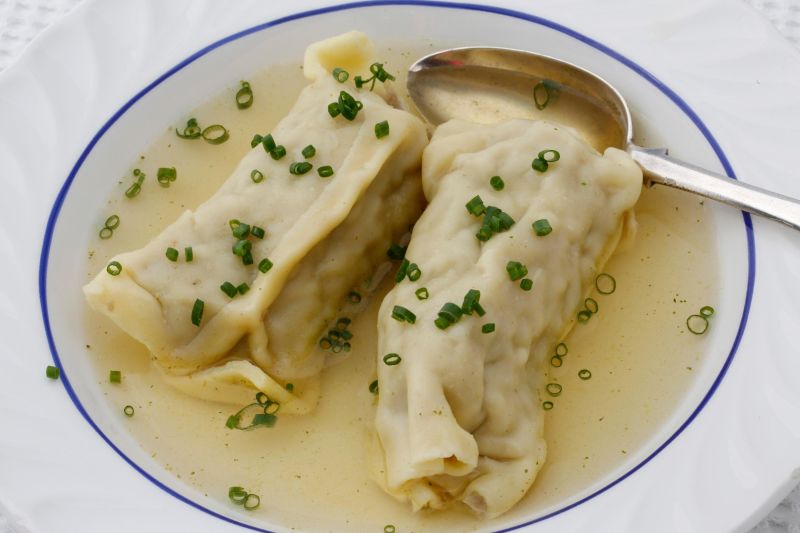
Maultaschen from Swabia, southwestern Germany, are a lot like ravioli but bigger. They are typically palm-sized, square pockets of dough with fillings that run the gamut from savory to sweet and meaty to vegetarian.
A traditional combination is minced meat, bread crumbs, onions and spinach – all seasoned with salt, pepper and parsley. They’re often simmered and served with broth instead of sauce for a tender, creamier treat, but are sometimes pan-fried and buttered for extra richness.
Today you can find maultaschen all over Germany (even frozen in supermarkets) but they’re most common in the south.
Here the delicious dumplings have become so important that in 2009, the European Union recognized Maultaschen as a regional specialty and marked the dish as significant to the cultural heritage of the state of Baden-Württemberg.
Labskaus is not the most visually appealing dish, but a delectable mess that represents the seafaring traditions of northern Germany like no other. In the 18th and 19th centuries, ship provisions were mostly preserved fare, and the pink slop of labskaus was a delicious way of preparing them.
Salted beef, onions, potatoes and pickled beetroot are all mashed up like porridge and served with pickled gherkins and rollmops (see below). It has long been a favorite of Baltic and North Sea sailors.
Today the dish is served all over northern Germany, but especially in Bremen, Kiel and Hamburg. And while on modern ships fridges have been installed, it remains popular as a hangover cure.
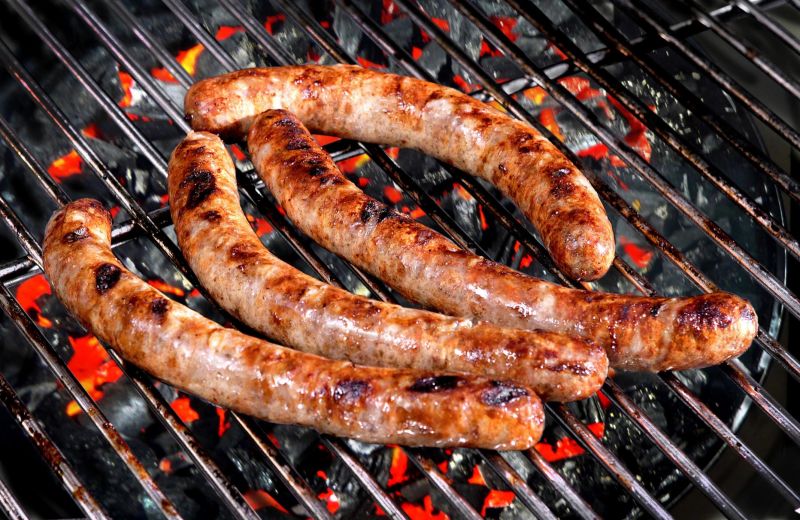
There is no Germany without sausages.
There are countless cured, smoked and other varieties available across wurst-loving Germany, so, for this list we will focus on some of the best German street food: bratwurst, or fried sausages.
There are more than 40 varieties of German bratwurst. Fried on a barbecue or in the pan, and then served in a white bread roll with mustard on the go, or with potato salad or sauerkraut as the perfect accompaniment for German beer.
Some of the most common bratwurst are:
– Fränkische bratwurst from Fraconia with marjoram as a characteristic ingredient.
– Nürnberger rostbratwurst that is small in size and mostly comes from the grill.
– Thüringer rostbratwurst from Thuringia, which is quite spicy. Thuringia is also the home of the first German bratwurst museum, which opened in 2006.
The most popular incarnation of bratwurst, however, is the next item on our list.
Practically synonymous with German cuisine since 1945, currywurst is commonly attributed to Herta Heuwer, a Berlin woman who in 1949 managed to obtain ketchup and curry powder from British soldiers, mixed them up and served the result over grilled sausage, instantly creating a German street food classic.
Today boiled and fried sausages are used, and currywurst remains one of the most popular sausage-based street foods in Germany, especially in Berlin, Cologne and the Rhine-Ruhr, where it’s usually served with chips and ketchup or mayonnaise or a bread roll.
Not the most sophisticated of dishes, but a filling street snack born out of necessity about which all of Germany is still mad: some 800 million are consumed a year.
Döner kebab was introduced to Germany by Turkish immigrant workers coming here in the 1960s and ’70s. One of the earliest street sellers was Kadir Nurman, who started offering döner kebab sandwiches at West Berlin’s Zoo Station in 1972, from the where the dish first took both West and East Berlin by storm and then the rest of Germany.
From its humble Berlin beginnings when a döner kebab only contained meat, onions and a bit of salad, it developed into a dish with abundant salad, vegetables (sometimes grilled), and a selection of sauces from which to choose.
Veal and chicken spits are widely used as is the ever-popular lamb, while vegetarian and vegan versions are becoming increasingly common.
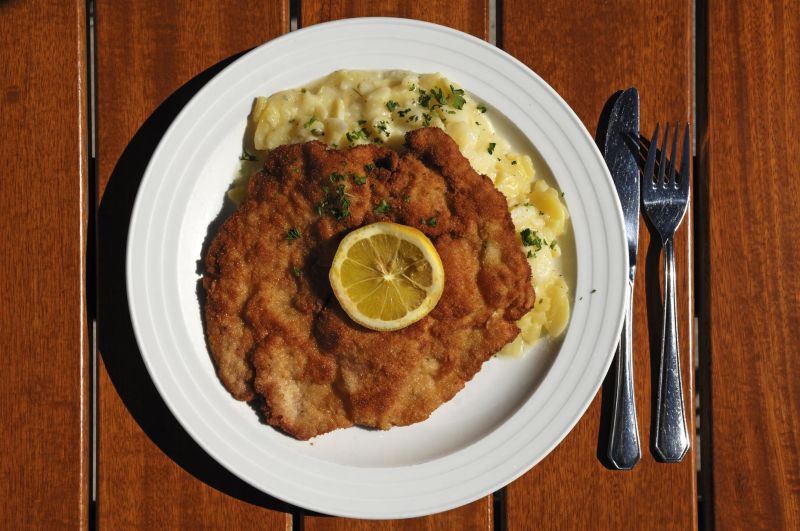
Some might argue that schnitzel is Austrian and not German, but its origins are actually Italian.
This controversy hasn’t stopped the breaded and fried meat cutlets to become popular everywhere in Germany, however. While the Austrian or Vienna schnitzel is by law only made with veal, the German version is made with tenderized pork or turkey and has become a staple of most traditional restaurants.
Whereas Vienna schnitzel is served plain, Germans love to ladle a variety of sauces over their schnitzel. Jägerschnitzel comes with mushroom sauce, zigeunerschnitzel with bell pepper sauce and rahmschnitzel is served with a creamy sauce.
All go well with fried potatoes and cold lager or a Franconian apple wine.
Spätzle originally come from Baden-Württemberg. Essentially a sort of pasta, the noodles are a simple combination of eggs, flour, salt and often a splash of fizzy water to fluff up the dough. Traditionally served as a side to meat dishes or dropped into soups, it can be spiced up by adding cheese: the käsespätzle variant is an extremely popular dish in southern Germany, especially Swabia, Bavaria and the Allgäu region.
Hot spätzle and grated granular cheese are layered alternately and are finally decorated with fried onions. After adding each layer, the käsespätzle will be put into the oven to avoid cooling off and to ensure melting of cheese. Käsespätzle is a popular menu item in beer gardens in summer and cozy Munich pubs in winter.
Rouladen is a delicious blend of bacon, onions, mustard and pickles wrapped together in sliced beef or veal. Vegetarian and other meat options are also now widely available but the real deal is rinderrouladen (beef rouladen), a popular dish in western Germany and the Rhine region.
This is a staple of family dinners and special occasions. They are usually served with potato dumplings, mashed potatoes and pickled red cabbage. A red wine gravy is an absolute requirement to round off the dish.
Sauerbraten is regarded as one Germany’s national dishes and there are several regional variations in Franconia, Thuringia, Rhineland, Saarland, Silesia and Swabia.
This pot roast takes quite a while to prepare, but the results, often served as Sunday family dinner, are truly worth the work. Sauerbraten (literally “sour roast”) is traditionally prepared with horse meat, but these days beef and venison are increasingly used.
Before cooking, the meat is marinated for several days in a mixture of red wine vinegar, herbs and spices. Drowned in a dark gravy made with beetroot sugar sauce and rye bread to balance the sour taste of the vinegar, sauerbraten is then traditionally served with red cabbage, potato dumplings or boiled potatoes.
This is another messy and not necessarily optically appealing dish, but nevertheless definitely worth trying. Himmel und erde, or himmel un ääd in Cologne (both mean “Heaven and Earth”) is popular in the Rhineland, Westphalia and Lower Saxony. The dish consists of black pudding, fried onions and mashed potatoes with apple sauce.
It has been around since the 18th century, and these days is a beloved staple of the many Kölsch breweries and beer halls in Cologne, where it goes perfectly well with a glass or three of the popular beer.
Germany’s most beautiful places
Zwiebelkuchen and federweisser
October is the month to taste the first wines of the year in Germany, and a well-known culinary treat in the south is federweisser und zwiebelkuchen (partially fermented young white wine and onion tart).
Federweisser literally means “feather white” and is made by adding yeast to grapes, allowing fermentation to proceed rapidly. Once the alcohol level reaches 4%, federweisser is sold. It is mostly enjoyed near where it is produced. Because of the fast fermentation, it needs to be consumed within a couple days of being bottled. In addition, the high levels of carbonation means that it cannot be bottled and transported in airtight containers.
In most towns and cities along the Mosel River, people flock to marketplaces and wine gardens in early October to sip a glass of federweisser and feast crispy, freshly made onion tarts called zwiebelkuchen. Because of its light and sweet taste, it pairs well with the savory, warm onion cake.
World politics in a pig’s stomach. Saumagen was made famous by former Chancellor of Germany Helmut Kohl, who (like the dish) hailed from the western Palatinate region. Kohl loved saumagen and served it to visiting dignitaries including 1980s British Prime Minister Margaret Thatcher, Soviet leader Mikhail Gorbachev and US Presidents Ronald Reagan and Bill Clinton.
The literal translation of this dish is “sow’s stomach,” but saumagen is a lot less curious than its name implies.
Somewhat resembling Scottish haggis, it is prepared by using the stomach of a pig (or an artificial one) as a casing for the stuffing made from pork, potatoes, carrots, onions, marjoram, nutmeg and white pepper.
It is then sliced and pan-fried or roasted in the oven, and, as Kohl knew, goes down perfectly well with sauerkraut, mashed potatoes and a dry white wine from the Palatinate.
Pinkel mit grünkohl, or cooked kale and sausage, is a delicious winter comfort food eaten mainly in northwest Germany, especially the region around Oldenburg, Bremen and Osnabrück as well as East Frisia and Friesland.
The cooked kale is mixed with mustard and bacon, and the “pinkel” sausage (named after the pinky) is made of bacon, groats of oats or barley, beef suet, pig lard, onions, and salt and pepper.
Germans sometimes celebrate winter with a traditional so-called “Grünkohlfahrt,” where family and friends go on a brisk hike accompanied by schnapps and finished off with a warm kale dinner in a country inn.
Germans are mad about white asparagus. As soon as harvest time arrives around mid-April, asparagus dishes appear on the menus of restaurants all over Germany, from Flensburg to Munich and Aachen to Frankfurt.
This is spargelzeit, the time of the asparagus, and it is celebrated with passion. During spargelzeit, the average German eats asparagus at least once a day. This adds up to a national total of over 70,000 tons of asparagus consumed per year.
No one can truly say where this fixation with white asparagus comes from, but the first document that mentions the cultivation of this vegetable around the city of Stuttgart dates to the 1686. There are spargel festivals, a spargel route in Baden-Württemberg and countless stalls along the roads of Germany selling the “white gold.”
In restaurants, asparagus is boiled or steamed and served with hollandaise sauce, melted butter or olive oil. It comes wrapped in bacon or heaped upon schnitzel; as asparagus soup, fried asparagus, pancakes with herbs and asparagus, asparagus with scrambled eggs or asparagus with young potatoes. There is an audible sigh all over Germany when spargelzeit ends on June 24, St. John the Baptist Day.
Fried potato pancakes are so popular in Germany that we have more than 40 names for them. They are known as reibekuchen, kartoffelpuffer, reibeplätzchen, reiberdatschi, grumbeerpannekuche and so on and so on.
Another quintessential German comfort and street food, reibekuchen are often served with apple sauce, on black pumpernickel rye bread or with treacle (a type of syrup).
They’re popular all year around: in Cologne and the Rhineland they are beloved of revelers during the Karneval festivities in spring, and all German Christmas markets have reibekuchen vendors where hundreds of litres of potato dough are being processed every day during the holiday season.
Why Germany is the bread capital of the world
Rollmöpse (plural) are cooked or fried and then pickled herring fillets, rolled around a savory filling like a pickled gherkin or green olive with pimento, and have been served on the coasts since medieval times.
Becoming popular during the early 19th century when the long-range train network allowed pickled food to be transported, Rollmöpse have been a staple snack on German tables ever since.
Rollmöpse are usually bought ready-to-eat in jars and are eaten straight, without unrolling, or on bread and sometimes with labskaus (see above). And like labskaus, they are commonly served as part of the German katerfrühstück or hangover breakfast.
Germany has a vast variety of cakes, but among the most popular is the Schwarzwälder kirschtorte or Black Forest gateau.
The cake is not named after the Black Forest mountain range in southwestern Germany, but the specialty liquor of that region, Schwarzwälder kirsch, distilled from tart cherries.
Allegedly created by Josef Keller in 1915 at Café Agner in Bonn in the Rhineland, it typically consists of several layers of chocolate sponge cake sandwiched with whipped cream and sour cherries, and then drizzled with kirschwasser. It is decorated with additional whipped cream, maraschino cherries and chocolate shavings.
Its popularity in Germany grew quickly and steadily after World War II, and it’s during this period that the kirschtorte starts appearing in other countries too, particularly on the British Isles.
Whatever the reason for its success, it is both perfect for kaffee und kuchen in a German cafe on a Sunday afternoon as well as dessert.
There are rarely any strawberries in German cheesecake (or any other fruits for that matter), and the base is surely not made from crackers but freshly made dough (or even without base, like in the East Prussian version).
The filling is made with low-fat quark instead of cream cheese and egg foam is added to give it more fluff, plus lemon and vanilla for some extra freshness.
Maybe this purity and the focus on a handful of ingredients is why a version of cheesecake exits in almost every region of Germany: there’s käsekuchen, quarkkuchen, matzkuchen and even topfenkuchen in Austria.
Wherever you try it, you can be sure that it is the perfect treat with some added fresh cream and a hot cup of coffee.
This dessert is another immigrant legacy and is popular with German children.
Spaghettieis is an ice cream dish made to look like a plate of spaghetti. Vanilla ice cream is pressed through a modified noodle press or potato ricer, giving it the appearance of spaghetti. It is then placed over whipped cream and topped with strawberry sauce representing the tomato sauce and white chocolate shavings for the Parmesan.
Besides the usual dish with strawberry sauce, there are also variations with dark chocolate ice cream and nuts available, resembling spaghetti carbonara instead of spaghetti bolognese.
Spaghetti ice cream was invented in 1969 by Dario Fontanella, son of an ice cream-making Italian immigrant in Mannheim, Germany. Thankfully for us and perhaps unfortunately for Dario, he didn’t patent his spaghetti ice cream and it is today available at almost every ice cream parlor anywhere in Germany.
Dario did, however, receive the “Bloomaulorden,” a medal bestowed by the city of Mannheim, for his culinary services in 2014.
Don't Miss
CNN — The escalating climate crisis is shifting many people’s purchasing patterns and this extends to the $500 billion dollar
CNN — With one of the world’s most diverse food scenes, China makes it nearly impossible to put together one
‘It felt electric from the time we took the field’: Tom Brady speaks about first NFL game in Germany Tom
Best Chinese food: 32 must-try dishes
CNN
—
With one of the world’s most diverse food scenes, China makes it nearly impossible to put together one single list that truly encompasses the “best” Chinese dishes.
But with such a huge variety of flavors on offer, it’s immensely helpful to go into the country with an introductory list of essential eats that will give you a well-rounded culinary experience.
Below are some of the can’t-miss dishes.
We have included both English and Chinese (Mandarin or Cantonese, depending how they are more commonly known) names in this story.

One bite into this small mountain of crispy duck skin, juicy meat, radish, cucumber, scallion and sweet bean sauce wrapped neatly in a thin pancake, and you’ll understand why Peking duck has been captivating stomachs – including those of ancient Chinese emperors – for centuries.
It’s said that roasted duck first started tantalizing taste buds more than 1,500 years ago in Nanjing, when the city was the seat of ancient Chinese imperial regimes.
The capital relocated to Beijing in the 1400s, and the imperial families brought those tasty roast duck recipes – and the chefs – with them.
It was there that the current way we enjoy the duck, wrapped in that delicate thin pancake, was invented and then popularized around the world.
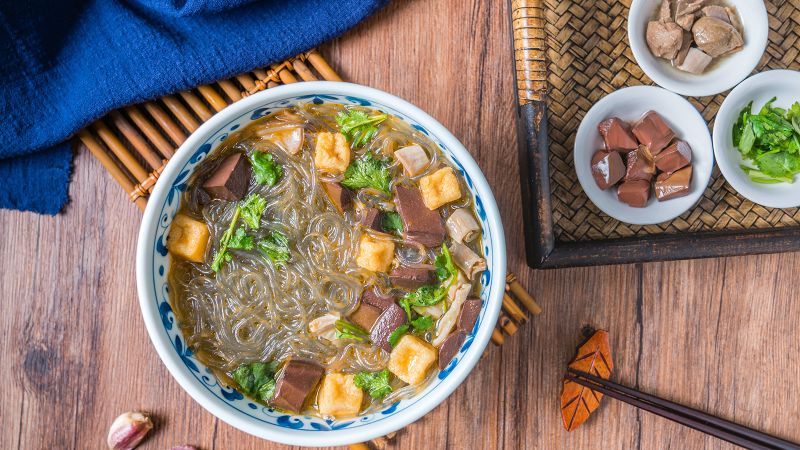
Many Nanjing residents will indeed tell you it’s their city – not Beijing – that’s the true duck capital of China.
The city’s obsession with the bird is evident in its wide array of duck offerings, including salted duck, pancakes made with duck grease and duck dumplings.
But nothing speaks to a duck lover’s heart quite like a cheap bowl of vermicelli soup with duck blood.
Made with duck-bone broth, duck blood curds and bits of duck offal, such as liver and gizzards, this street food dish fully utilizes every part of the bird to deliver incredibly intense flavors.
It may look simple, but steaming fish is a difficult art to master.
Timing is crucial. The number of minutes – or seconds – you should steam a fish is dictated by the type and size of a fish, as well as the strength of your own stove.
Undercook it by a minute, the flesh won’t detach from the bone; overcook it, the flesh will tighten too much and the fish will lose some of its moisture, tenderness and flakiness.
Cantonese steamed fish is usually served in some sweetened soy sauce and scallions.
It’s nearly impossible to dislike China’s soul-comforting dan dan mian, or dan dan noodles. The question is: Which version to try?
Dan dan noodles are named after the way they were originally sold more than 100 years ago – on a dan dan, a carrying pole, by street hawkers.
There are many ways to serve this famous Sichuan specialty. Some think dan dan noodles should contain a dry mix of noodles, made with minced meat, chopped scallions, spices, crushed peanuts and various sauces. Others disagree, preferring dan dan noodles in a hot, spicy, salty and nutty broth albeit with similar ingredients.
But most people would agree that dan dan noodles taste better when topped with a handful of rou saozi – finely chopped pork that’s been pan-fried in lard until golden brown and crispy.
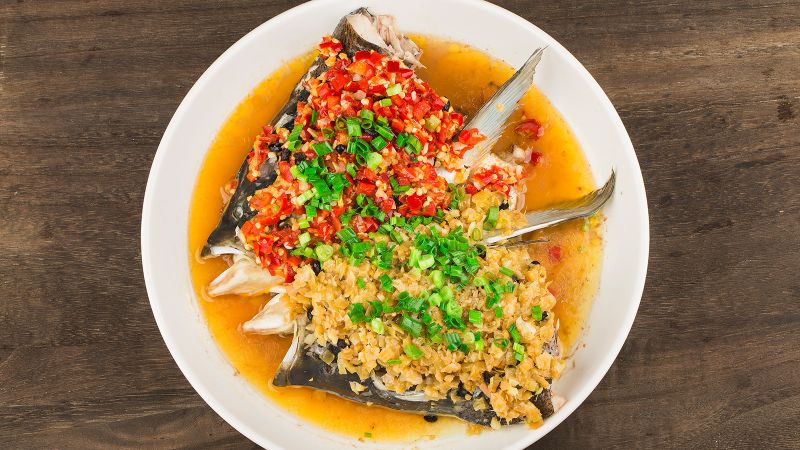
Cuisine in the mountainous, landlocked southern province of Hunan (also known as Xiang cuisine) is often cooked with a generous portion of oil, salt and chili.
The province even has its own chili-themed folk song, with lyrics proclaiming that “it doesn’t count as a dish if there is no chili. A touch of chili triumphs over an exquisite meal.”
No other dish represents Hunan cuisine as well as steamed fish heads served with chopped salted chili (duo jiao yu tou).
Duo jiao, a staple relish in Hunanese homes, is made with chili peppers that are dried, diced then preserved in a jar of salt, ginger, garlic and baijiu (Chinese liquor) for at least a week.
The thick blanket of duo jiao gives the steamed fish head a salty and spicy kick. The leftover juice is a delicious dip for noodles or dumplings after you’ve devoured the fish.
Warning: Once you’ve tried a Cantonese-style, woodfire oven-roasted goose, there’s no going back. No other goose dish will please your palate in quite the same way.
Upon hitting your mouth, the goose magically falls apart, offering an explosion of combined flavors from the crispy skin, melted fat and tender meat.
Some restaurants will use special types of wood, such as camphor wood or lychee wood, to give the bird a special smoky taste.
Seaside Chaozhou is known for no-frills seafood dishes that serve one purpose – to maximize the fresh ingredients’ original umami flavors.
Among the best dishes showcasing this style is Chaozhou-style cold fish or cold crab.
To preserve the freshness of the seafood, fish and crabs are lightly seasoned in salt before they’re steamed. They’re then cooled and served at room temperature.
The fish is often dipped in a special soy bean paste from Poling, while the crabs are served with a garlic and vinegar sauce.
Legend has it that cross-the-bridge rice noodles were invented many years ago by a loving wife. Her husband studied on an island, so the wife would travel across a bridge to deliver him his daily lunches.
As the food would be cold after the journey, the disheartened wife decided to bring a pot of scalding hot chicken broth, along with the rice noodles and raw ingredients.
It was an ingenious plan, really. The chicken oil on the surface of the soup would keep the liquid warm. When the husband was ready to eat, she’d cook all the ingredients by pouring them into the hot soup.
Today, many noodle shops offer their own style of cross-the-bridge rice noodles, offering a choice of different ingredients and soup bases.
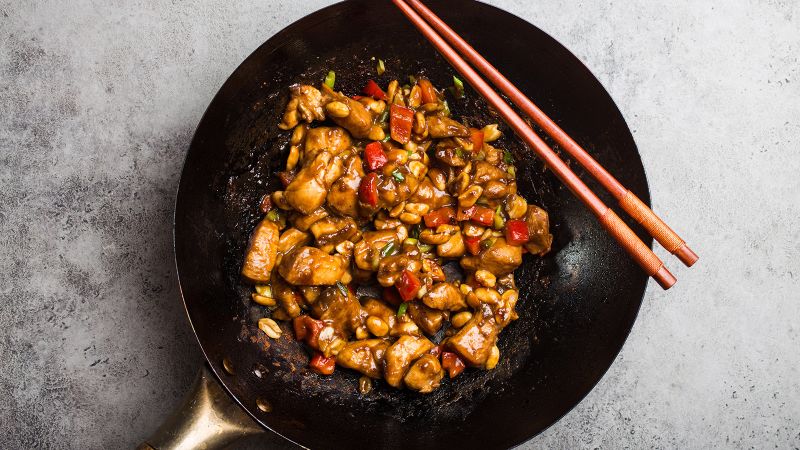
One of the most internationally famous Chinese dishes, Kungpao chicken is made by stir-frying diced chicken pieces with scallions, ginger, peppercorns, chili and deep-fried peanuts.
There are different origin stories, but many believe the dish was inspired by a former Sichuan governor in the 1800s called Ding Baozeng, whose nickname was Ding Gongbao – alternatively romanized as Kungpao.
It’s said that Ding loved a sour and salty fried chicken dish from China’s Shandong province. After he was relocated to Sichuan, he asked his chef to add some local chili and peanuts to the dish – and the rest is history.
Sweet and sour pork / Lychee pork
Deep-fried pork can feel a bit heavy, especially in unforgiving summer weather. Thankfully, we have sweet and sour pork.
The pineapple in the dish and a sauce made with sugar, vinegar and soy sauce add some freshness to the crispy pork.
If you’re a fan of sweet and sour pork, you should also try the Fujian version of the dish – lychee pork. By incising the surfaces of the pork pieces, they resemble lychees’ uneven skins after being deep-fried.
There is no lychee in the dish traditionally – the sweetness comes from sugar, but some restaurants add lychee or use lychee sauce to match its name.
Bonus: The rugged surfaces on the pork hold more sauce and have a more tender texture.
Who needs French fries when you have dumplings?
Whether you love them steamed, boiled or pan-fried, jiaozi pack a full punch of carbs, proteins and vegetables in one mouthful.
Vinegar and chili oil are some of the best condiments to go with Chinese dumplings.
One of the most interesting styles of dumplings is Fujian’s rouyan version – delicious enough to earn their own spot on this list.
The mini pork dumplings have an extra chewiness to them as their wrappers are made of pork and some flour.
While Hainanese chicken rice isn’t actually from China’s Hainan province (it was first served in Malaysia), the dish was inspired by the tropical island province and its famous Wenchang chicken.
Made with a special breed of poultry from the island’s eponymous city, Wenchang chicken is prized for its thin skin, tender meat and sweet flavor.
The most common way to cook a Wenchang chicken is by blanching and air drying it. Similar to Hainanese chicken rice, the Wenchang version is often served with yellow chicken fat rice and chicken soup.
Hainan locals usually prefer garlic and ginger paste, chili sauce and the juice of small tangerines as condiments.
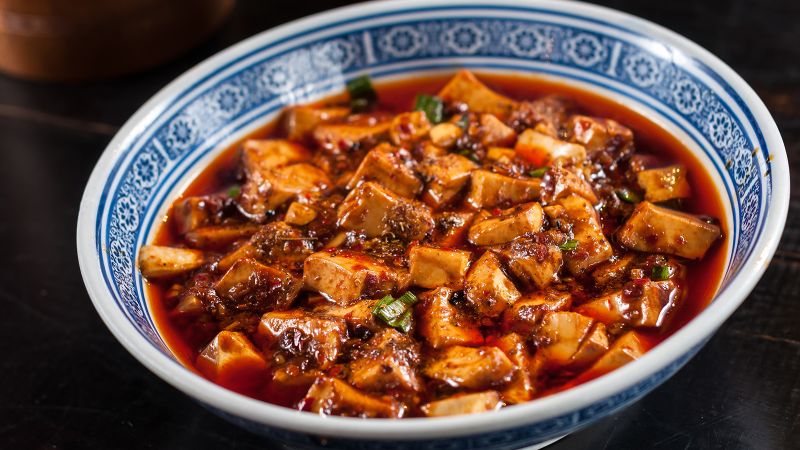
A memorable mapo tofu packs a boatload of zing – salty, peppery and spicy flavors should all hit the taste buds in a single spoonful thanks to the different types of spices, peppers and chili used in the dish.
Discerning local gourmets insist that the best mapo tofu should be made with Hanyuan peppercorns and broad bean chili paste from Sichuan’s Pidu district.
It’s most commonly cooked with minced pork or beef – and tofu, of course. But as the Sichuan dish is so wildly popular nowadays, restaurants often serve creative versions of mapo tofu with different types of meats.
Tender, well-braised pork belly is naturally irresistible – but the star of this Hakka dish is actually mei cai, a dry, pickled Chinese mustard that gives the hearty stew its sour and salty taste.
It’s said that every Hakka family, a traditionally nomadic tribe in China, pickle their own mei cai.
When they make too much of it, they will whip up a mei cai relish that’s a great topping for plain rice and noodles.
Whether it’s an elevated version made with diced abalone and truffles, or a leftover medley of soon-to-spoil ingredients from your fridge, every good version of classic fried rice shares two important ingredients – dry but succulent rice and wok hei (also known as the breath of the wok).
One of the most welcome sights on a cold morning in Tianjin in northern coastal China is a jian bing stand, with its sizzling hot pan.
Jian bing guozi is composed of two elements: Jian bing (crepes) and guozi (deep-fried crisps).
To make a jian bing guozi, first, a mung bean mixture is fanned out with a ladle onto a flat-iron pan. Eggs and scallions are then spread out on the crepe.
After the pancake is flipped over, a dollop of bean paste, sheets of guozi crisps (or, sometimes, deep-fried breadsticks and vegetables) are added before the vendor – usually an elderly man – folds the stuffed and toasted pancake and hands it to you in a paper bag.
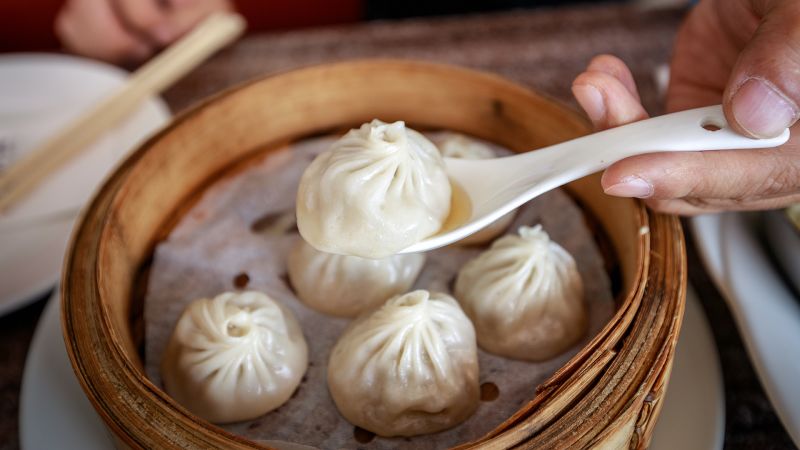
Wondering whether the xiaolongbao wrapper will break on the long journey between the steaming basket and your mouth is one of the most suspenseful moments that can take place at a dining table.
Amassing a huge following in and outside China, xiaolongbao, also called xiaolong tangbao (translated as “small basket soup bun”), is a mix of soup and pork packed inside a thin dumpling wrapper.
In addition to pork, the soupy dumplings can also be filled with crab meat and crab roe.
If you’re one of those people who thinks the real star of beef chow fun is the noodles and not the beef, you should try Chen cun fen (Chen village flat rice noodles).
Chewier, wider and thinner than the usual flat rice noodles, Chen cun fen is a specialty from Chen village, a town in Shunde district in the Pearl River Delta.
In addition to being stir-fried in a noodle dish, the semi-translucent and smooth Chen cun fen make a great base layer for dishes such as steamed spareribs and seafood as the noodles absorb all the flavors from the other ingredients.
Named after famous poet, painter and statesman Su Dongpo (who lived about 1,000 years ago), Dongpo rou is made up of braised pork belly, rock sugar, soy sauce, yellow wine and other seasonings.
The result is a richly flavored and extremely tender pork slab that can easily be pried apart with chopsticks.
It’s a delicious dish that goes well with steamed white rice.
Hot and sour soup
Surprisingly, China’s famed hot and sour soup isn’t just great at warming up your body in winter.
Local Sichuanese believe that the soup can also expel excessive humidity and hotness from one’s body in summer as well.
A bowl of hot and sour soup should have a balance of sourness (from vinegar) and spiciness (from peppers) – but not hotness from chili.
Shreds of tofu, Chinese mushrooms, wood ears and bamboo shoots are some of the common ingredients found in the thick soup.
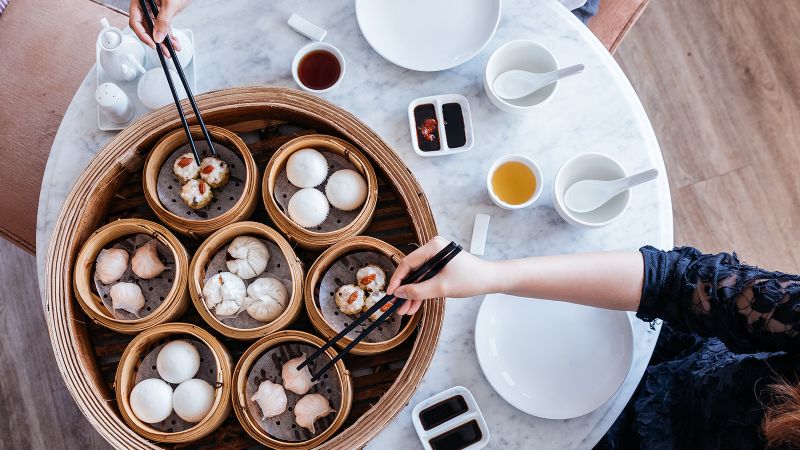
Dim sum refers more to a style of serving food – it’s a type of meal in Cantonese food culture – rather than a specific dish.
It’s a cunning way to include many different varieties of small plates – from pan-fried radish cake to prawn dumplings to siu mai – in one meal.
At the same time, dining on a combination of these dishes during a dim sum session is far more enjoyable than eating just one version on its own.
Don’t be fooled by its bland-sounding Chinese name – shui zhu, which translates literally to “water boil.”
Shui zhu is a cooking technique that was first developed in Sichuan cuisine. The word water (shui) refers to the hot, spicy chili oil broth that is used to poach thinly sliced beef (shui zhu niu), pork (shui zhu roupian) or fish (shui zhu yu).
Today, the photogenic crowd-pleaser is often served with sliced celtuce (a type of lettuce) and flat mung bean noodles in the broth, too.
The best barbecue pork should be slightly charred on the outside and contain just the right amount of sweetness and saltiness from the maltose, wine and soy sauce.
A Cantonese roast shop will let you choose the level of fattiness you want in your char siu, Cantonese for barbecue pork.
Half lean, half fatty char siu is the go-to option if you are a newbie.
Barbecue pork is a highly versatile ingredient served in many delicious dishes – from char siu macaroni soup for breakfast to char siu bao – steamed buns –– at dim sum.
Bao – a steamed bread roll filled with a variety of ingredients including meat or vegetables – come in many shapes and sizes.
It could be a plain bao with a glossy and smooth exterior (mantou), or an oversized steamed volcano-shaped bao stuffed with an entire meal’s worth of food (da bao, or translated as “big bao”).
But one of the best baos is undoubtedly sheng jian bao.
The pan-fried bao is filled with pork and broth, while scallions and white sesame seeds are sprinkled on top.
The Mausoleum of Terracotta Warriors is usually the reason travelers visit Xi’an, but this western Chinese city’s delicious and similarly historical rou jia mo is another great reason to head there.
The ubiquitous street eat consists of a grilled mo (flat bread) and an overflowing amount of shredded pulled pork belly that has been braised in soy sauce, rock sugar and spices such as cinnamon, star anise, cloves and peppercorns for hours.
Undercooked mo is a big no-no. A common saying in Shaanxi province goes “tie quan hu bei juhua xin,” which means “iron ring, tiger’s back and chrysanthemum’s heart ” – the perfect patterns you should look for on a well toasted mo.
Cantonese parents are the real experts when it comes to therapeutic herbal soups, which are simmered for hours to infuse the liquid with healing qualities and deliciousness.
Various seasonal ingredients offer different cooling or warming qualities to restore balance in the body.
For example, apple, snow fungus and lily petal soup will hydrate your body, whereas winter melon and barley soup will cool you down in hot weather.
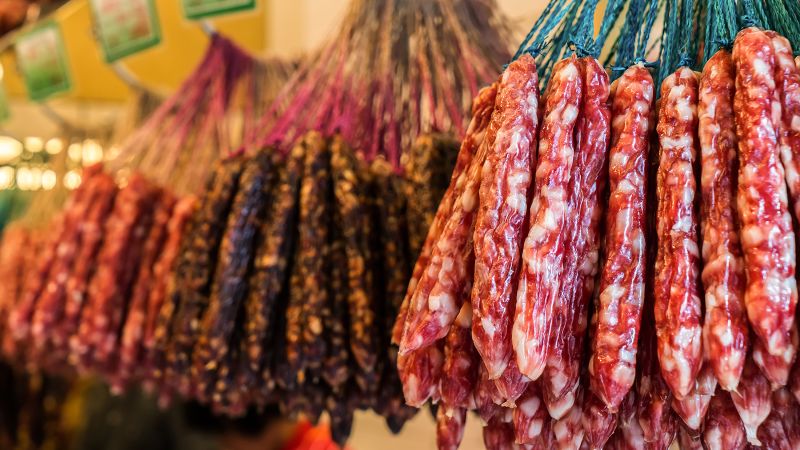
The Chinese version of salami is often categorized into two main types: Laap cheung and yun cheung (in Cantonese).
Laap cheung is preserved meat sausage that has a slightly sweet taste. Yun cheung, on the other hand, is mostly made with offal from poultry, giving it a stronger and gamier flavor.
Unlike their European counterparts, Chinese preserved sausages should be steamed before eaten.
You can find them wrapped in buns, stir-fried with sticky rice or steamed in a clay pot.
The secret to a delicious Fujian-style taro paste is binlang yu, a special breed of yam from Fujian’s Fuding county. The white and purple flesh of a binlang yu has vibrant fragrances and an earthy, nutty and sweet taste.
To make the dessert, the taro is cooked and mashed before it’s mixed with sugar and lard.
The thick, silky taro mash will then be garnished with sweet toppings such as dates, candied cherries and gingko.
When it comes to nourishing your digestive system, in sickness and in health, it’s all about congee (porridge, commonly made with rice).
A popular breakfast item in many parts of China, the versatile cheap eat can be served plain with a drizzle of soy sauce and scallions, or stewed with savory ingredients such as chicken or fish.
Lean pork floss and century egg congee is one of the classics served in the south of China. Congee made with millet instead of rice and flavored with pumpkin is popular in the north.
Those who are extra hungry can order a side of soy sauce-fried noodles, deep-fried breadsticks (youtiao) or soy milk. These can be enjoyed on the side, or you can tear up the breadsticks or add some noodles to the congee.
Most people who visit Chaozhou can’t resist picking up a family-sized bag of super bouncy and flavorsome meat balls made of beef beaten by hand to bring home with them.
Highly praised for their understanding of beef, Chaozhou people are also famous for other dishes such as beef hot pot.
One of the most loved desserts in China, sweet rice balls, or tangyuan, can be found in many regions.
Ningbo is one of the best places to sample these round mochi-like desserts.
The soft, pillowy exterior is made with sticky rice while the filling is made of black sesame, sugar and lard.
The lard gives the filling an extra fragrance and sheen.
Don't Miss
CNN — The escalating climate crisis is shifting many people’s purchasing patterns and this extends to the $500 billion dollar
CNN — Hong Kong is widely considered one of the most challenging cities in the world to operate a restaurant
To tackle Thailand’s mounting trash problem, one company is turning to the country’s plant life. Universal Biopack makes packaging that

